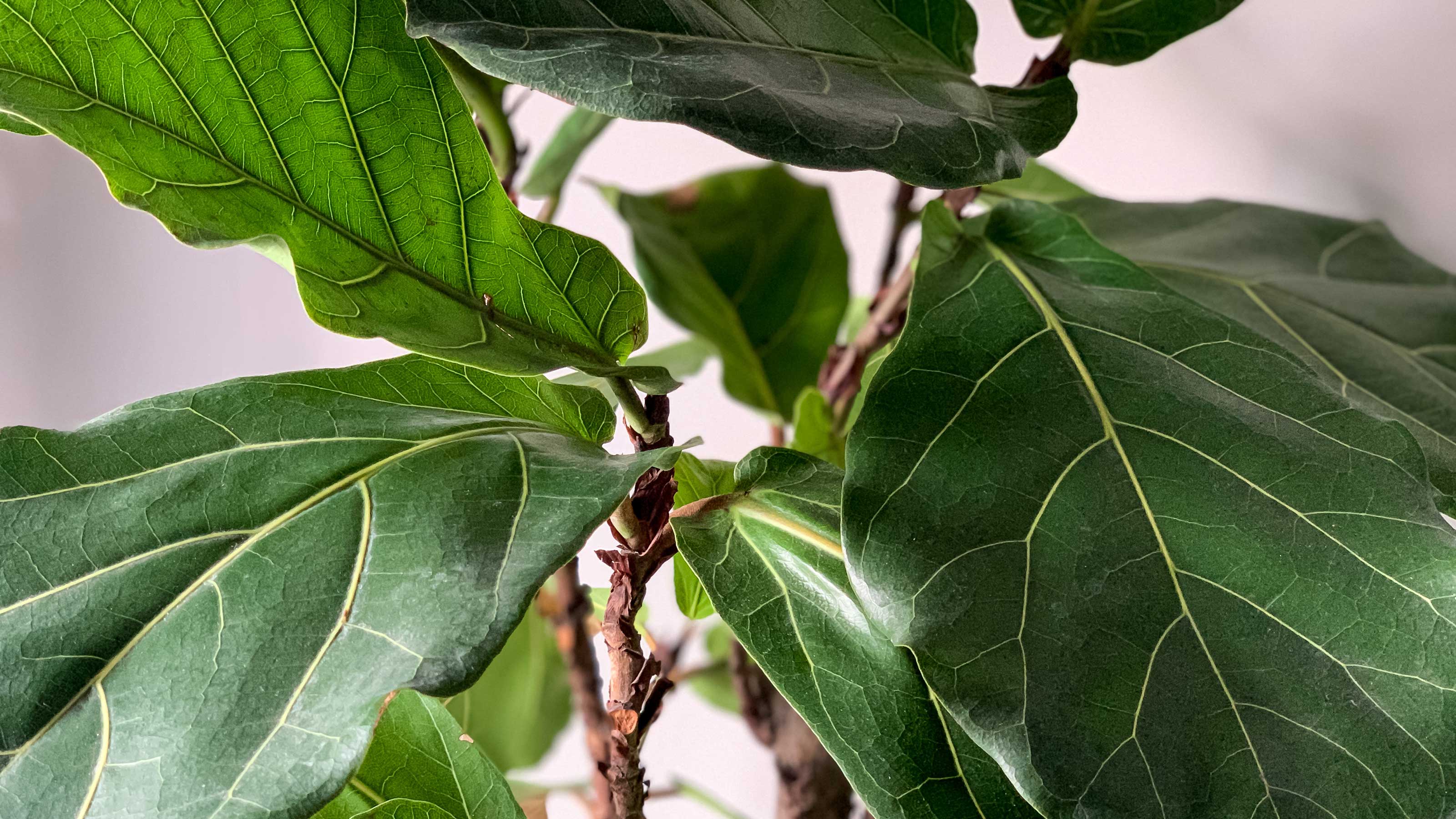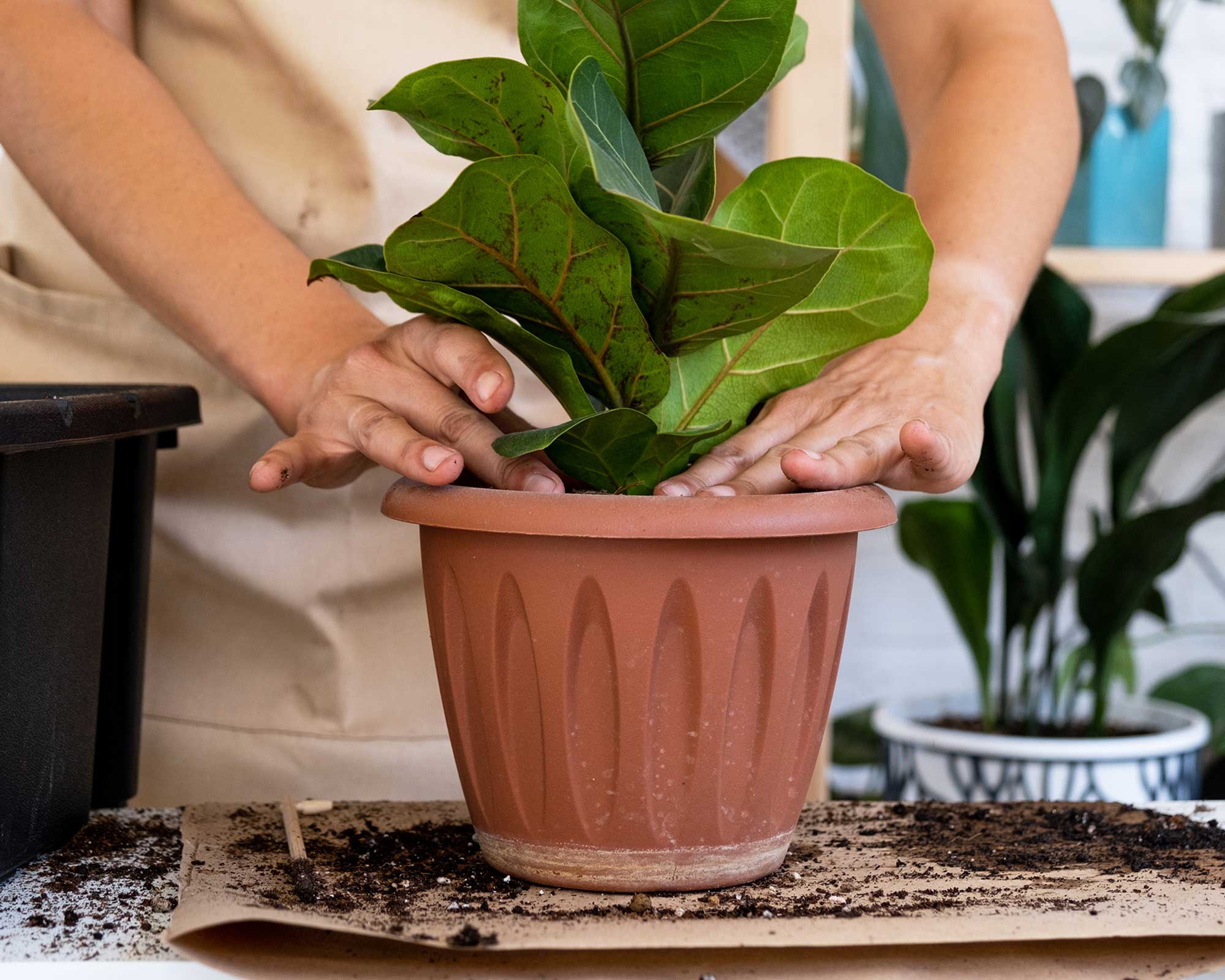How to care for a fiddle leaf fig — 8 expert tips to help these houseplants thrive
Caring for a fiddle leaf fig requires a bit of know-how. This pro advice will keep yours looking green and gorgeous


Knowing how to care for a fiddle leaf fig correctly is important if you have one in your home. Their large, glossy foliage and impressive height make them a perfect focal point – but only if they’re looking their best.
Fiddle leaf figs aren’t the easiest houseplants to look after. Watering, pruning, and temperature all need to be considered, as our experts point out. There are also common problems to be mindful of, including leaf drop and bug infestations.
But putting in the extra effort is worth it for the botanical beauty these plants bring to a room. We teamed up with green-fingered pros to get the lowdown on exactly what fiddle leaf figs need, so you can keep these indoor plants happy and healthy.
How to care for a fiddle leaf fig, according to the experts
Avoid killing your houseplants with this advice – it’s simpler than you might expect once you’ve got the know-how.
1. Don't overwater it

Perhaps the most crucial factor when caring for houseplants is providing the right amount of water, at the right time. And, for fiddle leaf figs, it’s essential not to overdo it.
Kiersten Rankel, an expert from Greg, a houseplant-care app, says, “Fiddle leaf figs are sensitive to root rot and prefer regular periods of dry soil between waterings."

Kiersten Rankel is a certified Louisiana Master Naturalist and regularly volunteers with local community gardens and nonprofits to help restore critical ecosystems along the Gulf Coast. In her spare time, she enjoys hiking and tending to her 150+ houseplants and vegetable garden.
You can check if it’s time to water by using a chopstick – a tip from Vladan Nikolic (Mr. Houseplant). “Stick the chopstick in the soil, to the bottom of the pot, and pull it out,” he instructs. “If it comes out clean with no soil sticking to it, your plant is thirsty.”
Get small space home decor ideas, celeb inspiration, DIY tips and more, straight to your inbox!
Drooping leaves are also a sign it’s time to water your plant, Vladan notes.
“The precise watering schedule depends on environmental conditions, such as light, humidity, temperature, and plant size,” he continues. “For example, plants that get more light need to be watered more frequently. That’s why it’s best to always check the soil moisture before watering.”
We love this rose glass watering can from Terrain – it's perfect for keeping houseplants hydrated.

Vladan Nikolic, otherwise known as Mr. Houseplant, is a houseplant expert with over 10 years of experience. He is the founder of the houseplant care blog MrHouseplant.com and also an influencer who helps newcomers in the houseplant world become great plant parents. You can find him on Instagram, TikTok, YouTube, Facebook, Twitter and Pinterest.
2. Plant it in well-draining soil

Kiersten recommends planting fiddle leaf figs in a fast-draining potting mix, such as Perfect Plants indoor plant soil from Amazon. She also suggests adding a handful of perlite, orchid bark, like SuperMoss orchid bark from Amazon, or pumice to the mix to allow for good aeration. Horticultural grade pumice from The Succulent Cult at Amazon will do nicely.
You can buy organic perlite from Perfect Plants Nursery.
“Soggy soil quickly leads to root rot, so be sure to plant them in a pot with a drainage hole as well,” she adds.
3. Offer enough light

According to Autumn Hilliard-Knapp, a plant expert from Perfect Plants Nursery, fiddle leaf figs prefer bright, indirect light. “They can tolerate some direct sunlight in the morning or late afternoon, but avoid placing them in direct sunlight for long periods, as this can scorch the leaves,” she says.
They’re sensitive to change, notes Kiersten. “Once they’re in a happy spot, try not to move them!”

Autumn is a horticulture specialist and marketing professional at Perfect Plants Nursery. With four years of experience in the horticulture industry, she has developed a passion for helping people create beautiful indoor and outdoor spaces to enjoy. Her expertise in horticulture encompasses a broad range of activities, including plant care and selection, landscape design, and maintenance.
4. Up the surrounding humidity

Anastasia Borisevich, a plant expert at Plantum, recommends keeping the humidity high around your fiddle leaf fig. If the humidity level drops below 50–60%, she recommends misting it regularly. “Use a fine mist sprayer for this. It creates a ‘fog’ around the plant and moisturizes the foliage evenly, preventing large drops of water from gathering on the leaves.”
This copper mister from Anthropologie is great for all your tropical, humidity-loving plants, and looks super cute, too.
5. Keep it warm

Hailing from the rainforests of western Africa, it’s no surprise fiddle leaf figs like to stay warm. According to Anastasia, a temperature range between 66°Fahrenheit and 81°F is preferred.
They also need protection from drafts and drastic temperature changes. This is especially important right after watering them, Anastasia adds, as their growing medium can overcool easily.
6. Prune the leaves properly

Laurelynn G. Martin and Byron E. Martin of Logee's Greenhouses point out that fiddle leaf figs tend to be vertical growers and, over time, can reach a substantial height.
While perhaps not the best houseplant for a small space, they can be pruned to keep their size and shape more under control. But, there are a few tips to bear in mind before trimming your plant.

Laurelynn G. Martin and Byron E. Martin are the authors of Edible Houseplants and co-owners of Logee’s Greenhouses in Danielson, Connecticut, a business that has been in the Logee-Martin family since 1892. They are nationally recognized experts in growing tropical container plants.
First, do it at the right time: spring or summer is best, when the plant is actively growing, says Autumn. Second, avoid removing more than 20% of the leaves at a time, warns Kiersten. Otherwise, you can stress the plant. Third, always use sterilized pruning shears, like Fiskars bypass pruners from Amazon, to avoid spreading pathogens.
And finally, as always when pruning plants, make your cuts just above a healthy growth node (a bump on the stem) or a healthy leaf. Brown, dead leaves can be cut off at any time. Remember to wear gloves when pruning your fiddle leaf fig, as the sap is an irritant. Floral Cotton Garden Gloves from Terrain are not only useful, but adorable to boot.
7. Apply some fertilizer – if conditions are right

Feeding fiddle leaf figs when they are actively growing can help to give them a boost, but only if the lighting is right.
"If grown in some direct sunlight, they can be fertilized once a month with a dilute solution of fertilizer," advises Laurelynn and Byron. Under low light, little to no fertilizer is recommended, they add.
This organic fiddle leaf fig fertilizer from Amazon is a well-rated option.
8. Keep an eye out for pests

It's worth knowing how to identify houseplant pests to protect your plants from harm.
For fiddle leaf figs, some of the most common culprits are spider mites. These can be prevented by regularly wiping down the leaves with a damp cloth and providing adequate humidity, says Autumn.
Scale and mealybugs can also be problematic. Again, wiping the leaves can help, as can applying an insecticidal soap, such as this one from Bonide’s at Amazon.

These reliable, steel-blade pruners are perfect for tidying up your fiddle leaf fig and other indoor and outdoor plants.

This houseplant potting soil includes perlite, sand, and pine bark for improved drainage and reduced soil compaction.

Keep your hands protected while pruning and repotting your fiddle leaf fig with these gorgeous gloves.
FAQs
Why are the leaves drooping on my fiddle leaf fig?
“Droopy leaves can indicate inadequate watering, sudden environmental change, overfertilizing, or pests,” says Vladan.
You may need to readdress your care routine and check for bugs. If you’ve given your plant too much fertilizer, Vladan recommends removing it from its pot, rinsing the roots with clean running water, and repotting it into fresh soil to try and save it.
Similarly, a severely overwatered plant may need repotting into new, dry soil. When you remove it from its original pot, inspect the roots and cut any rotten areas away before replanting.
Why are the leaves falling off my fiddle leaf fig?
“A few yellow or dropped leaves here and there are normal,” says Kiersten. “But, if new growth looks yellow or begins to drop, it means they’re getting too much water."
She suggests putting the plant in a brighter spot and giving it a few extra days between waterings.
Are fiddle leaf figs toxic?
Unfortunately, these plants are toxic to both pets and humans. Remember to wear gloves when handling them and keep them safely away from children and your four-legged friends.
Once you’ve got to grips with caring for your fiddle leaf fig, consider expanding your collection with more leafy additions to give your space a jungle-like vibe. If you fancy less of a challenge, there are plenty of easy houseplants to pick from, including the ever-popular spider plant.

The garden was always a big part of Holly's life growing up, as was the surrounding New Forest, UK, where she lived. Her appreciation for the great outdoors has only grown since then; over the years, she's been an allotment keeper, a professional gardener, and a botanical illustrator. Having worked for Gardeningetc.com for two years, Holly now regularly writes about plants and outdoor living for Homes & Gardens.
In her spare time, Holly loves visiting local English gardens and is particularly fond of relaxed cottage-garden schemes. She also loves prairie-style planting – the tapestry effect of grasses mixed with drought-tolerant blooms never ceases to delight her. Always happiest around plants, when she isn't swooning over gardens, she's looking after her ever-growing collection of houseplants and arranging seasonal flowers in her apartment to paint.
